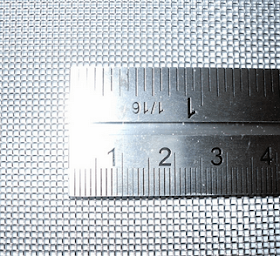Sieves and screens are widely used in pharmaceutical manufacturing as well as in the quality control to determine the particle size of the raw materials. Mesh is the most common measurement unit used for the sieves and screens. Generally, 40 to 400 mesh sieves are used in pharmaceutical manufacturing during shifting and milling of raw material.

1. Granulation: Required particle size ensures uniform granule size for consistent tablet weight.
2. Powder blending: It helps to achieve homogeneous mixing during blending.
3. Milling: It helps to control particle reduction and prevent segregation.
4. Coating and compression: Optimum particle size is helpful in smooth flow and uniform coating.
Particle size distribution obtained from sieving helps to determine dissolution behavior and content uniformity of the product.
For reference:
1 mm) = 1,000 microns
Human hair diameter ≈ 70 microns
Particle size of pharmaceutical powders ranges from 10 to 500 microns
Above table is widely used in pharmaceutical laboratories to convert mesh to micron and micron to mesh to interpret sieve analysis results and in manufacturing to use required sieve for raw material used in manufacturing.
Mesh x Micron =14900 (Approx)
Micron = 14900/mesh, and
Mesh = 14900/micron
It has some errors but it is still useful to get an approximate value while converting between 50 to 400 mesh. This variation is shown in the table.
Mesh and inches conversion can be done using the following formula.
Inch= 0.6/mesh
Mesh= 0.6/inch
ASTM E11: It has standard specification for wire cloth and sieve analysis.
ISO 3310-1: It has standards for test sieves of metal wire cloth.
USP and IP: these pharmacopoeias provide sieve numbers and mesh sizes for official tests.
These standards are useful for laboratories, manufacturing and regulatory submissions.
What is Mesh Size?
Mesh is the number of openings in one linear inch of any sieve or screen. Mesh size defines the number of holes in one square inch of sieve. A 10 mesh sieve will have 10 openings and a 400 mesh sieve will have 400 openings in one linear inch.
Mesh Size and Its Importance in Pharmaceuticals
Mesh analysis is commonly used in quality control labs to determine particle size of material and in manufacturing for powder characterization. It is important in different processes in manufacturing.1. Granulation: Required particle size ensures uniform granule size for consistent tablet weight.
2. Powder blending: It helps to achieve homogeneous mixing during blending.
3. Milling: It helps to control particle reduction and prevent segregation.
4. Coating and compression: Optimum particle size is helpful in smooth flow and uniform coating.
Particle size distribution obtained from sieving helps to determine dissolution behavior and content uniformity of the product.
Understanding Microns
Micron also known as micrometer is a unit of length equal to 1 millionth part of a meter (1 µm = 0.001 mm = 10⁻⁶ m). It is used to describe the size of very fine particles that are difficult to measure in millimeters and inches.For reference:
1 mm) = 1,000 microns
Human hair diameter ≈ 70 microns
Particle size of pharmaceutical powders ranges from 10 to 500 microns
Relationship Between Mesh Size and Micron
Mesh and Micron are inversely related. When the Mach number increases the opening size in microns decreases. The exact size of mesh number depends on the wire diameter used in the sieve. Conversion tables like ASTM E11 or ISO 3310-1 are used for accurate comparisons of mesh and microns.Mesh to Micron Conversion Chart
Following is the conversion table for the mesh to micron and inch.Above table is widely used in pharmaceutical laboratories to convert mesh to micron and micron to mesh to interpret sieve analysis results and in manufacturing to use required sieve for raw material used in manufacturing.
Mesh to Micron Conversion Formula
There is no official formula to convert the mesh to micron and vice-versa. I have tried to develop a conversion formula that gives approximately the correct conversion from mesh to micron and vice versa.Mesh x Micron =14900 (Approx)
Micron = 14900/mesh, and
Mesh = 14900/micron
It has some errors but it is still useful to get an approximate value while converting between 50 to 400 mesh. This variation is shown in the table.
Mesh and inches conversion can be done using the following formula.
Inch= 0.6/mesh
Mesh= 0.6/inch
Determination of Mesh Size of any Screen:
It is a very simple method to determine the mesh size of any sieve or screen. Carefully mark the sieve for 1 inch using a permanent marker and scale. Measurement should start from the centre of the wire to make it more accurate. Count the number of holes in this area. The number of holes in one linear inch is known as the mesh. For example: if 60 holes are found in an inch then the sieve will be of 60 mesh. These holes can be counted using the marker pen.Standards and Guidelines
Pharmaceutical sieve and mash calibration is governed by international standards such as:ASTM E11: It has standard specification for wire cloth and sieve analysis.
ISO 3310-1: It has standards for test sieves of metal wire cloth.
USP and IP: these pharmacopoeias provide sieve numbers and mesh sizes for official tests.
These standards are useful for laboratories, manufacturing and regulatory submissions.
Tips for Consistent Sieving Performance
- Calibrate sieves periodically for its authenticity and check for any damage before use.
- Always clean sieves with a soft brush avoiding any damage or an ultrasonic cleaner after use.
- Use recommended sample weight on sieves to avoid overloading.
- Record all data including ID, mesh size and duration of test during use.





Ok
ReplyDelete